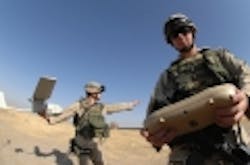Military must work fast to make its aircraft avionics compatible with NextGen air traffic management system
SAN DIEGO, 4 June 2010. The U.S. military has started to investigate how its aircraft could participate in the future air traffic management system known as NextGen, yet defense officials have a long way to go before they can even formulate requirements for NextGen-compatible avionics, much less actually deploy this kind of equipment in its aircraft, experts say.
The military has established a NextGen office in the Pentagon, yet is still far behind civil developments at the U.S. Federal Aviation Administration (FAA), says Bill Hershey, principal engineer at the MITRE Corp. in Dayton, Ohio. Hershey made his comments today at the Avionics USA conference and trade show in San Diego.
The military today has no requirements for NextGen avionics equipment in its aircraft, and so cannot make NextGen-related budget requests until it does, Hershey says. As a result it could be five years or more before the military could start designing and deploying NextGen-compatible avionics.
A second major consideration where NextGen and the military are concerned is need, Hershey points out. NextGen has many capabilities the military does not need now and probably will not in the future, such as required navigation performance (RNP) and Area Navigation (RNAV). Military aircraft typically operate from uncongested military air bases, and so do not have the advanced spacing needs of NextGen-related equipment for heavily used commercial airports.
Military aircraft typically are older than commercial jetliners, and sometimes do not have the technology necessary to participate in NextGen type air traffic control. "Some people say that nobody operates 707s anymore, but the military does," Hershey told Avionics USA attendees. He also points out the U.S. Air Force B-52 bomber is one of the oldest military air frames flying.
These older military aircraft do not have the electronic display technology necessary to participate in NextGen. Jet fighter aircraft, in addition, may have the display technology, but must use it for mission-related tasks, rather than for flying in commercial air space.
The military does, however, have needs for sharing commercial air space with commercial and general aviation aircraft, and needs transponder technology to enable them to do so, Hershey says.
The military's primary technology for reporting position information is the Mode-5 transponder, while civil aviation using NextGen technology is moving to automatic dependent surveillance-broadcast (ADS-B) equipment, which is a cooperative surveillance technique for air traffic control and related applications being developed for NextGen.
Hershey says military officials are starting to investigate the possibilities of merging Mode-5 transponder and ADS-B technologies for military use. "We really need to quicken our pace to get equipped," Hershey says.
Hershey points out that much of the NextGen-related military work has been done only with the U.S. Air Force, with hopes for involving the U.S. Navy, Army, and Marine Corps at a later time. Navy officials whose aircraft must operate from aircraft carriers may have different needs from the Air Force, particularly in transponder technology.
